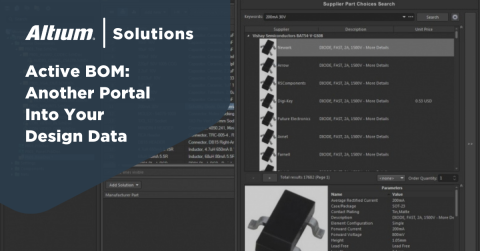PCB Component Data Management Resolved with Connected Component Applications
My mouth was watering as I picked up the box sitting on my front porch. Dinner would be ready in 20 minutes. I was so hungry, having just gotten home. The box contained recipe cards and ingredients for making dinners throughout the week. I put on my slippers, and I pulled a recipe card from the box. All the ingredients were there. This new meal delivery service was growing on me. I’d be eating dinner soon, with time to spare for needed downtime. I had skipped going to the grocery store. Everything I needed was in front of me, like magic.
Designing and building printed circuit assemblies is evolving in much the same way. I can stay focused on circuit ideas and leave assembly shopping to my powerful PCB software program. Rather than keeping a spreadsheet, manually, to create a BOM, I can place a symbol in my schematic and rest assured that its footprint, 3D dimensions, sourcing, and costing are instantly available in a format everyone can see. And, more importantly, I can see if the part is available along with electrical characteristics and datasheets. I no longer need to conduct separate searches to pull all information into one location; its already there, like magic.
Early Ad Hoc BOM Creation
When processes for making printed circuit boards were evolving from cutting tables, the steps for completing all the pieces were separate and done manually. I’d draw my circuit by hand, placing customary component symbols, and hand it over to a draftsman. I’d give the draftsman a manually generated spreadsheet that mapped component symbol to a location on the schematic.
The drafter had to research footprint and dimensional information to perform his work. While the draftsman was cutting the circuit, I created a BOM and gave it to my Supply Chain Coordinator. If supply chain found obsolescence, I’d go back to vendor websites searching for a solution. It was a long and laborious process. Now, I can solve obsolescence when creating the BOM with one click.
Solve obsolescence with one click
After the mad rush to get the manually-generated BOM information to my partners, I’d quietly return to my cube to work on the circuit. Without fail, the circuit evolved as the project evolved, and information on the BOM would change. More work would go into updating the BOMs, manually, and I’d share out new revisions. Like dominoes, the change would ripple through the team. When dealing with PCBs, component data management can be a pain.
Evolution of BOM Creation and Collection of Data
As changes caused revisions, partners noticed and brainstormed to streamline the process. We all wanted automation and wondered how to capture the information in one place, in one complementary software package. In time, schematic capture software evolved to include vendor information in the symbols. Menus allowed BOM creation, producing tab-delimited lists portable to other software formats.
Slowly, the schematic capture software integrated with the PCB layout software and libraries unified. Now, we have PCB integrated software that can talk to Management Information System software. Instead of creating multiple BOMs, we have unified environments where the originating information about electronic components, located in the schematic and integrated libraries, is available to all partners in the enterprise at any point in the build cycle. In addition, obsolete and sourcing information is available early, so solutions can be identified.
Instead of making circuits, listing components, and running to the store, the information is together and delivered to you. If a problem, such as component obsolescence is identified, your software tells you and provides a solution. Just like your meal service delivery, you’ve eliminated unnecessary work and bought yourself some peace of mind.
Unified Software Platforms Creates BOMs in One Place
In those years, we all wanted computers that would alleviate the redundancy of tracking information. Having to manually create and manage a BOM across differing departments, all tasked with complicated efforts to getting a PCA manufactured, was error-prone. Enterprises started combining part number assignment with footprint creation, keeping design data together within the PCB library.
Because differing departmental software didn’t talk together in those days, Purchasing and Supply Chain had their own, unique management information system software. They would use the unique corporate part number to track components for ordering. The unique enterprise part number was the link between all departments.
Early creation of within Altium identifies sourcing roadblocks early
Frequently, when the MIS software ran a BOM, the Supply Chain Coordinator would send copies to all members of the team for cross-checking with their manually-managed BOM. Everybody dropped what they were doing to implement the intricate changes.
Softwares, through the years, continue to evolve and continue to find ways of interacting seamlessly, able to share each other’s file formats. We are now seeing universal component libraries offered, easily portable to various processes within the enterprise. What used to be years of cumbersome and autonomous management of BOMs, with clunky processes for integrating, has become invisible to users.
Design engineers pick components for topologies, those components have real-world vendor information available within the symbol. When the schematic goes into PCB layout, the PCB librarian already has the footprint and dimensional information ported from the schematic via the component symbol. Costing and sourcing information is available, in real-time, for your Purchasing and Supply Chain, allowing alternates early in the design cycle.
Having information available early for BOM creation is now possible with Altium Designer’s unified environment. At any point in the design cycle, a BOM can be generated and reviewed.
If you find the idea of data management cumbersome and want to discuss more about how Altium Designer would be helpful for you, talk to an expert at Altium today.









